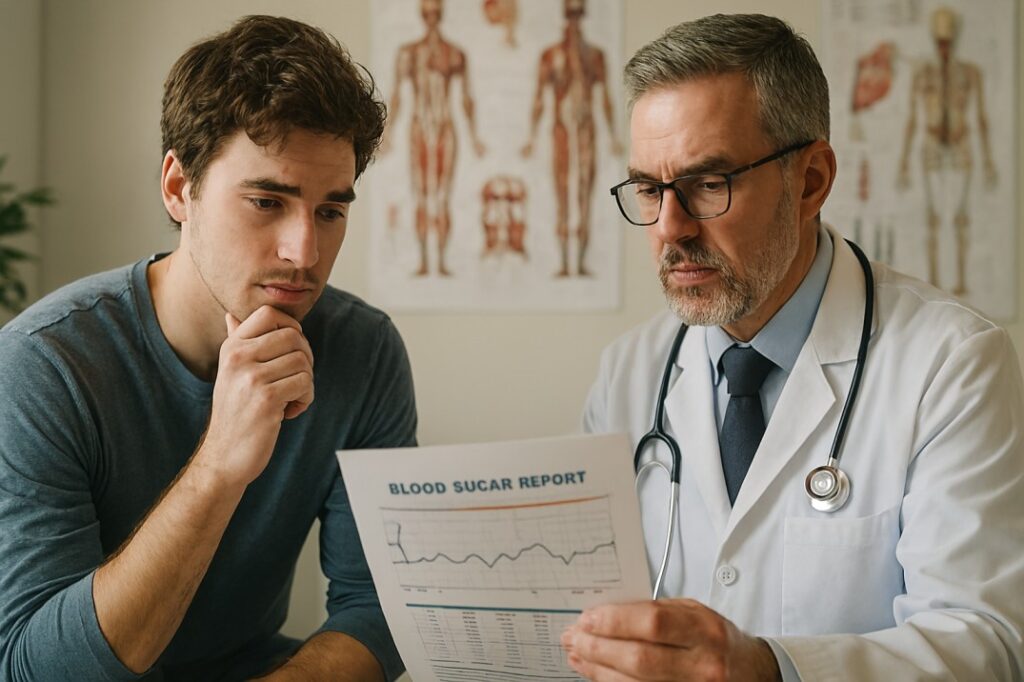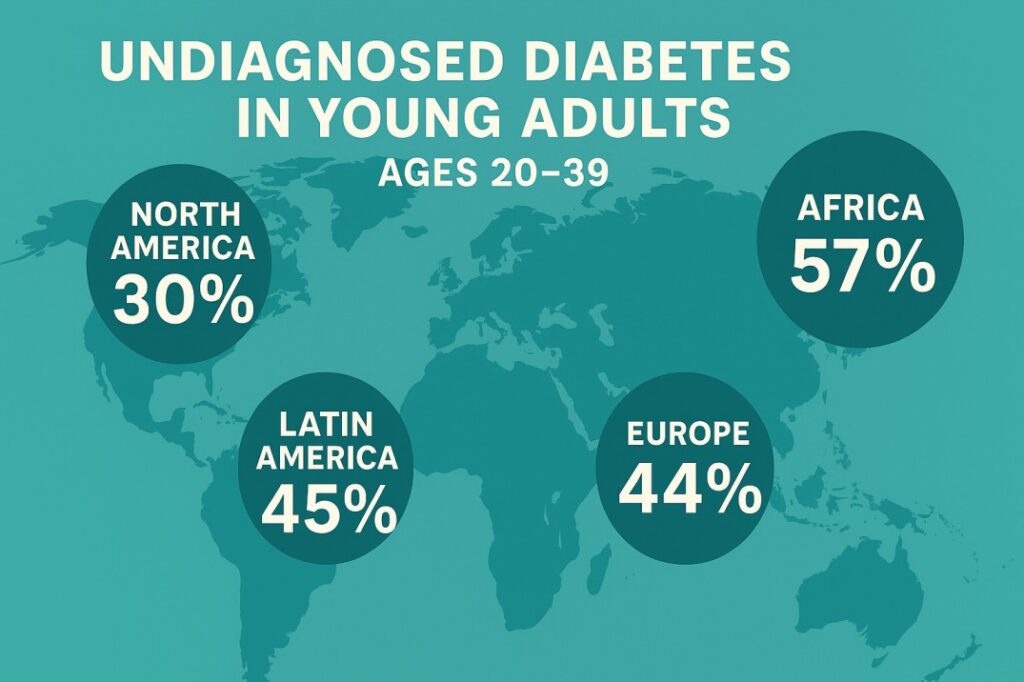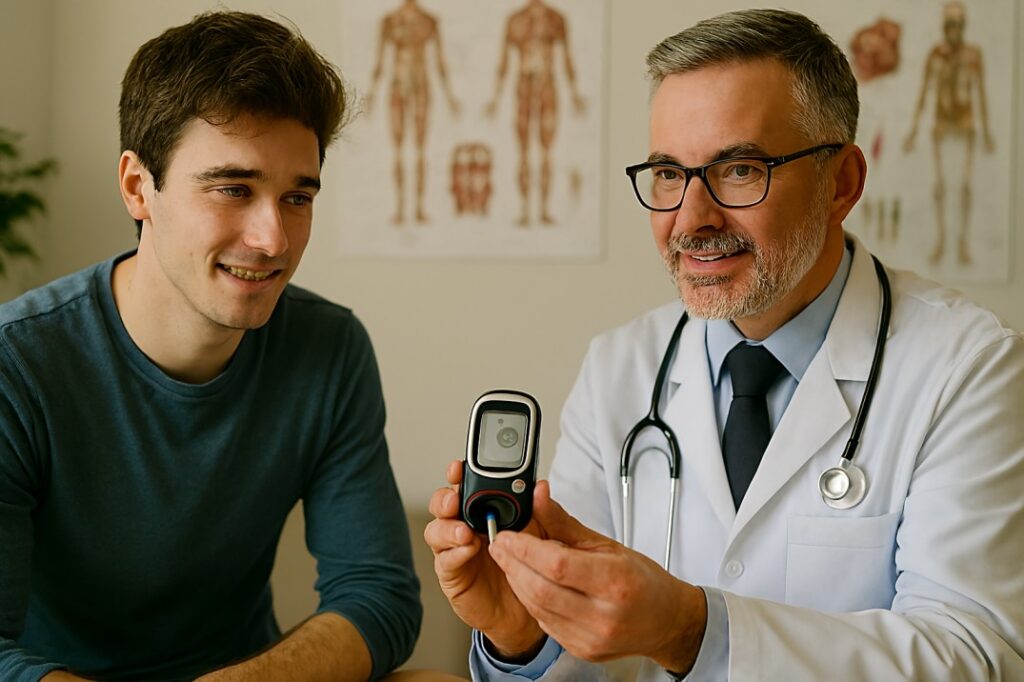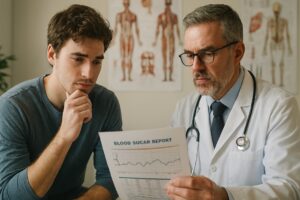
Undiagnosed diabetes in young adults medical checkup
Undiagnosed diabetes in young adults is rising. Many don’t know they have it. Learn the warning signs, risks, and why early screening is vital.
The truth about undiagnosed diabetes in young adults
A new global analysis has a simple, sobering message. Many people with diabetes do not know they have it. In fact, almost half of the people age 15 and older living with diabetes were estimated to be undiagnosed in 2023. This is not just a number. It is a public-health alarm bell. Young adults are among those most likely to be missed. Left untreated, diabetes can cause serious complications over time. So we must pay attention now. The Lancet, HealthData
What did the new study find about undiagnosed diabetes in young adults?

The new paper, published in The Lancet Diabetes & Endocrinology and led by researchers at the Institute for Health Metrics and Evaluation (IHME), reviewed decades of data from 2000 to 2023 across more than 200 countries and territories. The headline result: roughly 44% of people aged 15 and older with diabetes were undiagnosed in 2023. The Lancet
Importantly, the underdiagnosis was not evenly spread. Young adults — often defined as people between 15 and 39 years — showed especially high rates of being undetected. This matters. Young people live with the disease for longer if it goes untreated. That raises their lifetime risk of heart disease, vision loss, kidney damage, nerve injury, and other problems. HealthData, Healthline
Why are young adults being missed?

There are several reasons. First, doctors and patients often assume diabetes is a disease of older adults. So screenings may not be offered early. Second, early type 2 diabetes can be subtle. Symptoms may be mild or slow to appear. Third, access to testing varies widely. Low- and middle-income countries often lack routine screening. As a result, many cases slip through. The IHME team found big differences by region and income level. Diagnosis rates were much higher in high-income areas than in low-income regions. The Lancet, HealthData
What exactly does “undiagnosed” mean?
Simply put, “undiagnosed” means a person meets laboratory criteria for diabetes but has not been told by a clinician that they have the condition. Tests used to confirm diabetes include the A1C blood test, fasting plasma glucose (FPG), and the oral glucose tolerance test (OGTT). International bodies such as the American Diabetes Association (ADA) and the World Health Organization (WHO) define the thresholds for these tests. If a person crosses those thresholds and remains unaware, they are counted as undiagnosed. American Diabetes Association, World Health Organization
How big is the treatment gap?
The study also looked at care after diagnosis. It found that most people who know they have diabetes do receive medications. For example, the majority of diagnosed people were on pharmacological treatment. Yet treatment does not always equal good control. Globally, only a minority of people with diabetes had blood sugar levels in the optimal range while receiving treatment. That means many known cases are still not well controlled. Put together, this produces a large “cascade” of missed opportunities: people who are undiagnosed, and even among those diagnosed, many are not optimally treated. HealthData, Healthline
What are the signs and symptoms to watch for?

Symptoms can be subtle. Still, there are common red flags:
- Increased thirst and frequent urination.
- Unexplained fatigue.
- Slow healing of cuts and sores.
- Blurred vision.
- Unexplained weight loss.
If you notice any of these, do not ignore them. Also, remember that many people with early type 2 diabetes have no symptoms at all. That is why screening is important. The Lancet, World Health Organization
Who should get screened, and how often?
Guidelines vary by country and organization. However, a few broad points are clear:
- People with risk factors should get checked earlier and more often. Risk factors include overweight or obesity, family history of diabetes, high blood pressure, high cholesterol, and certain ethnic backgrounds.
- Some expert groups now recommend lowering screening age thresholds because of rising diabetes in younger people. For example, screening recommendations in the U.S. have been updated to expand eligibility in adults — a move meant to catch more cases earlier.
- Tests include A1C, fasting glucose, and OGTT. Your clinician will advise which test is right for you. CDC, American Diabetes Association
Why early diagnosis matters especially for young adults
Early detection saves harm. When diabetes is found early, lifestyle changes and treatments can reduce the risk of long-term complications. For young adults, early care can protect decades of health. Moreover, early control reduces the chance of costly medical problems later in life. Prevention and early treatment are far cheaper and less painful than treating advanced complications. World Health Organization, HealthData
What can health systems do?
The study’s authors and global health agencies suggest several actions:
- Expand routine screening in primary care.
- Make simple blood tests more widely available and affordable.
- Focus outreach on younger age groups as well as high-risk communities.
- Improve follow-up care and support for people who test positive, including lifestyle programs and access to essential medicines.
- Invest in public education so people know the symptoms and the need for testing. HealthData, World Health Organization
Practical steps you can take today
- Get tested if you have risk factors.
- Ask your doctor for an A1C or fasting glucose test.
- If you are under 40 but have a family history, do not assume you are safe.
- Improve diet and add physical activity. These help prevent and control type 2 diabetes.
- If diagnosed, follow medical advice and attend regular checkups.
Small steps now can prevent major problems later.
Undiagnosed diabetes in young adults — FAQs

Q: How common is undiagnosed diabetes globally?
A: The recent analysis estimated that about 44% of people aged 15 and older with diabetes were undiagnosed in 2023. This proportion varies by country and region. The Lancet
Q: Are young adults more likely to be undiagnosed?
A: Yes. Young adults showed particularly high rates of underdiagnosis in the study. That increases their lifetime risk of complications. HealthData
Q: What test confirms diabetes?
A: Diabetes is diagnosed using A1C, fasting plasma glucose, or an oral glucose tolerance test (OGTT). Guidelines from ADA and WHO set the thresholds. American Diabetes Association, World Health Organization
Q: Can lifestyle changes reverse diabetes?
A: In many people with early type 2 diabetes, weight loss, a healthy diet, and regular exercise can greatly improve blood sugar, sometimes to normal levels. However, not everyone reverses diabetes, and close medical follow-up is essential. World Health Organization
Q: Where can I learn more or get tested?
A: Talk to your primary care doctor. You can also visit reputable sources such as the WHO, CDC, or American Diabetes Association for guidance. World Health Organization, CDC, American Diabetes Association
This article is for information only. It is not medical advice. If you suspect you might have diabetes or have health concerns, see a licensed healthcare professional. Tests and treatment must be tailored to each person.
If you are 35 or older, have risk factors, or have any symptoms, ask your doctor for a blood sugar test today. Share this article with someone you care about. Early testing can change a life.
If you found these tips helpful, share this article with friends and family. For more science-backed health insights, explore our latest blogs on Nowspress.






